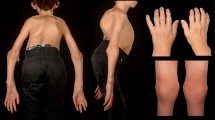Summary
The histopathologic changes are described in two mental defectives. One of these patients had the clinical diagnosis of mongolism and the findings are presented as the first pathologic report of cataracts in this disease. The second patient was not known to have mongolism but the histologic changes were similar and held to represent the same process in a later stage of development.
The pathologic abnormalities consisted first of proliferation of lens capsular material as wart-like excrescences protruding between epithelium and anterior capsule, associated with aberrations of the epithelium. With enlargement of these excrescenses and disappearance of the epithelium the capsule-like material underwent secondary degenerative changes and progressive displacement into the cortex.
These changes are compatible with the clinical appearance and progressive course of the opacities in mongolism. It is suggested that they underlie the coronary-cerulean type of cataract as well.
While the primary abnormality would appear to be an abiotrophy of the lens epithelium, analogous to other dystrophies in the eye, the chief pathologic manifestation is seen in aberrant proliferation of the capsule. This can be best appreciated with the periodic acid Schiff stain.
Résumé
Les modifications histologiques sont décrites chez deux déficients mentaux. Le premier était mongole et les observations anatomo-pathologiques rapportées, concernant les cataractes, sont les premières faites dans cette maladie. Le deuxième n'était pas mongole, mais les modifications histologiques étaient semblabes, elles paraissent appartenir au même processus pathologique, mais constituent un stade plus avancé.
On a relevé d'abord une prolifération de la cristalloïde, avançant comme une verrucosité entre l'épithélium et la capsule antérieure et associée à des anomalies épithéliales. Au fur et à mesure que ces formations augmentent, l'épithélium disparaît, les verrucosités ellesmêmes présentent des signes de dégénérescence secondaire et migrent vers la profondeur du cortex.
Ces observations anatomo-pathologiques concordent avez l'apparence clinique et la progression des cataractes mongoliennes. On peut penser qu'elles se retrouveront dans les cataractes coronaires et céruléennes.
Alors que l'anomalie primaire semble être une abiotrophie de l'épithélium cristallinien, analogue à d'autres dystrophies rencontrées dans le globe oculaire, la manifestation pathologique principale est constituée par une profilération aberrante de la capsule. C'est la coloration au PAS qui la met le mieux en évidence.
Zusammenfassung
Es wird über histopathologische Veränderungen bei zwei Schwachsinnigen berichtet. Der eine dieser Kranken war mongoloid und hatte eine Cataracta, was bisher histologisch nicht untersucht werden konnte. Der zweite Patient war nicht mongoloid, die histologischen Veränderungen waren aber die gleichen und wurden als Anzeichen desselben Prozesses in einem späteren Entwicklungszustand angesehen.
Es fand sich zuerst eine Proliferation der Linsenkapsel in Form von warzenartigen Wucherungen, die vor dem veränderten Linsenepithel und der Kapsel liegen. Bei Zunahme dieser Wucherungen schwindet das Epithel und es treten auch sekundäre Degenerationen darin auf, wobei die Veränderungen in die Rinde verlagert werden.
Dies stimmt mit den klinischen Erscheinungen überein, die dem Typus der cataracta coronaria coerulea entsprechen.
Die primäre Veränderung entspricht einer Abiotrophie des Linsenepithels, wie sie auch bei anderen Dystrophien vorliegt. Die Proliferation der Kapsel jedoch ist die typische krankhafte Erscheinung, die am besten mit der PAS-Färbung dargestellt werden kann.
Similar content being viewed by others
References
Lowe, R. F. (1949) The Eyes in Mongolism. Brit. J. Opthhal. 33, 131–174.
Igersheimer, J. (1951) The Relationship of Lenticular Changes to Mongolism. Trans. amer. ophthal. Soc. 49, 595–624.
Pearce, F. H., Rankine, R. & Ormond, A. W. (1910) Notes on 28 Cases of Mongolian Imbeciles: With Special Reference to Their Ocular Condition. Brit. med. J. II, 186–190.
Author information
Authors and Affiliations
Additional information
Howe Laboratory of Ophthalmology, Harvard University Medical School, Massachussetts Eye and Ear Infirmary, 243 Charles Street.
Rights and permissions
About this article
Cite this article
Cogan, D.G., Kuwabara, T. Pathology of cataracts in mongoloid idiocy. Doc Ophthalmol 16, 73–80 (1962). https://doi.org/10.1007/BF00146720
Issue Date:
DOI: https://doi.org/10.1007/BF00146720




